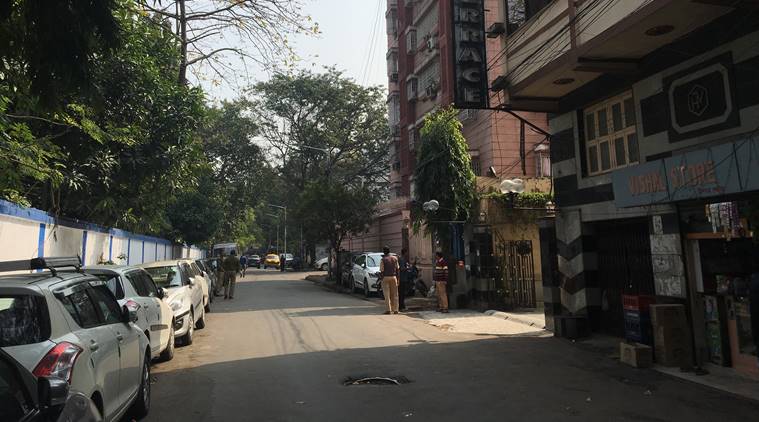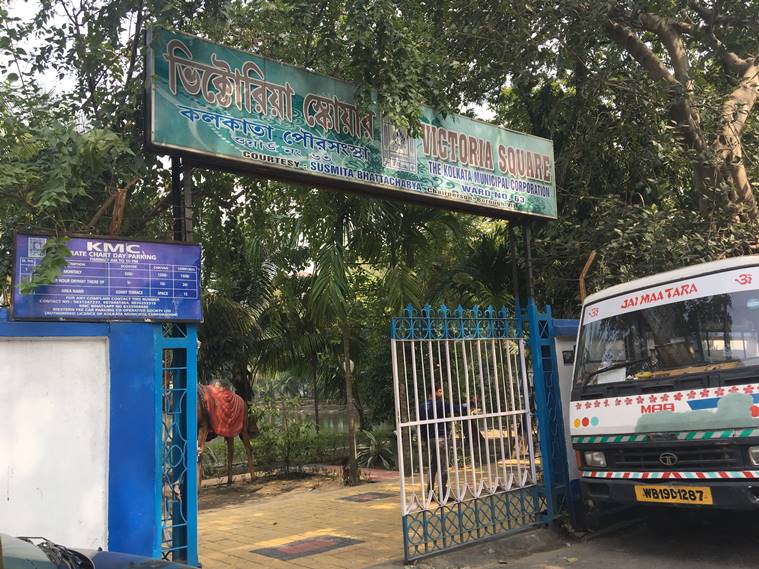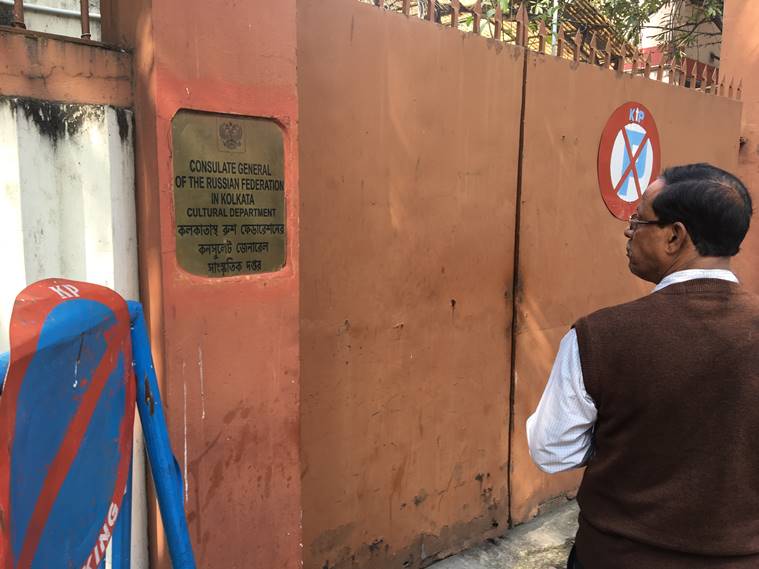Streetwise Kolkata: Upmarket Victoria Terrace was born out of a slum
by Neha BankaWritten by Neha Banka | Kolkata | Updated: January 31, 2020 6:22:38 pm

Although today neighbourhood is densely packed with modern buildings, during the late 1800s the area was home to a bustee or slum called Baman Bustee. (Express Photo: Neha Banka)
The central business district of Kolkata is a collection of several smaller neighbourhoods with unique characteristics and histories of their own. One of them is the relatively less-known, tree-lined Victoria Terrace. Rapid development, especially over the past four decades, has entirely changed its face, belying its origins as one of the city’s oldest neighbourhoods with a fascinating history.
Historian P Thankappan Nair, who has extensively written about the city of Calcutta, says the neighbourhood got its name after the reigning Queen Victoria on May 4, 1874. Two years later, she would adopt the self-appointed title of ‘Empress of India’. A document titled ‘Proceedings of the Justices’ in 1874, explains how the name of this street came to be. In the center of the neighbourhood lies the large Victoria Tank, also named after the Queen. The street to the north of this tank was originally called Dalhousie Street, but the residents of the neighbourhood petitioned the Calcutta Municipal Corporation for a change of name because it was commonplace for the street to be confused with the much larger Dalhousie Square in north Calcutta. The streets in the neighbourhood underwent a name change and Calcutta Municipal Corporation decided to rename the street to the north of the Victoria Tank as Albert Road. On the street to the south of the tank stood only two houses that were renamed Victoria Terrace. The two houses find mention in the ‘Proceedings of the Justices’ of 1874, of which only one remains today in a severely dilapidated condition, overtaken by squatters.
The origins of the neighbourhood are interesting in itself. Although today it is densely packed with modern buildings, during the late 1800s the area was home to a bustee or slum called Baman Bustee. Around 1858, the British East India Company engaged in land acquisition under the term “land reclamation” on areas occupied by bustees. According to the writings of S.W. Goode in his book ‘Municipal Calcutta: Its Institutions in Their Origin and Growth’, published by the Corporation of Calcutta in 1916, the first successful land acquisition occurred with regard to the Dunkin Bustee near Park Street, where huts and non-permanent residential establishments were occupied by people who worked as servants or in livery stables belonging to the city’s wealthy. The Dunkin Bustee, quotes Goode, was “a great nuisance to the residents within its immediate vicinity”.
The transformation of bustee land and the eviction of its dwellers were undertaken using funds of the Lottery Commission. At that time, the Company believed that this initiative had been a great success and were inspired to experiment with other bustees occupying prime real estate in the heart of the city, that were then cleared to make space for residential homes and offices for Company employees. Legally, the bustee dwellers were only tenants while the land on which they lived belonged to the East India Company.

Baman Bustee was cleared away to make space for Victoria Square and surrounding streets. (Express Photo: Neha Banka)
Baman Bustee, that was eventually cleared away to make space for Victoria Square and surrounding streets, including Victoria Terrace, writes Goode, was “bounded on the north by Theatre Road, on the east by Hungerford Street, on the west by Camac Street, and on the south by Lower Circular Road, opposite Woodburn Park Road, was about 54 bighas in area, and belonged to Mr. Peterson, a barrister.” There were no records immediately available on the identity of Peterson, the barrister, including his first name, but it was not unusual for Company employees to individually have ownership of relatively large areas of land inside the metropolis of Calcutta.
On the Victoria Tank, Goode writes that it was “in 1859 conveyed free of cost by Mr. Peterson to the (Lottery) Commissioners in perpetuity.” As with other bustees that had been cleared away by the British, the Lieutenant-Governor of Bengal, John Peter Grant, suggested that the now-empty plots of land be fenced with iron railings, a proposal that was very liberally applied elsewhere in the city and then entirely done away with over the years. The recently-cleared land of the Baman Bustee was also subjected to the same proposal.

Also in the Victoria Terrace neighbourhood are the British Council and the Gorky Sadan, the Russian Centre of Science and Culture. (Express Photo: Neha Banka)
The Lottery Commissioners were ordered to improve and add railings to the tank and construct a road 40 feet in width, linking “Wood Street with Circular Road, while two cross roads, each 30 feet in width, were to run east and west between Theatre Road and Circular Road linking Hungerford Street and Camac Street.” Goode writes that the remaining land in the neighbourhood was sold by Mr. Peterson for building sites, “on which only houses of a superior class, rented at not less than Rs. 80 per mensem, were to be erected.” During the 1800s, the term ‘mensem’ was used to refer to a month’s salary, the literal translation being ‘by the month’.
Goode goes on to write that these buildings that came up around the neighbourhood of Victoria Tank were “bounded by iron railings, except where the out-offices formed the compound wall.” It appears that in exchange for the “gift” of the Victoria Tank, the Lottery Commissioners led plans for the development of the land around the tank that belonged to Peterson that went on to become Victoria Square. The entire scheme, writes Goode, cost the city municipality Rs. 20,000. “On the credit side they also placed the clearance of a congested and insanitary area, the provision of several good sites for houses suitable for Europeans, and yielding a large sum in municipal rates, and lastly, a good supply of what was at that time accounted pure and wholesome water.”

Sometime during the 2000s, the old building at 2 Victoria Terrace was completely demolished and replaced with modern construction. (Express Photo: Neha Banka)
The two colonial style houses that were built on Victoria Terrace, adjacent to each other, were considerably large, with two to three storeys and were located at the corner of the Victoria Terrace and Camac Street crossing and had the postal addresses 1 and 2 Victoria Terrace respectively. Sometime during the 2000s, the old building at 2 Victoria Terrace was completely demolished and replaced with modern construction. The land of the large property on which the demolished building once stood, was subdivided to accommodate a residential building and Hotel Victerrace, named after the neighbourhood.
The other house on the corner of Victoria Terrace stands empty today, with a tropical-style portico in a severe state of disrepair, and piles of garbage in what was once its front courtyard and gardens. A roadside laundry service occupies the pavement right in front of the home. These days, taxi cabs use the grounds of the old house to evade parking fees because there is no security guard for oversight and the large iron gates of the building limply hang ajar and are used by squatters to dry clothes. Left to neglect and disrepair, a wild growth of plants has overtaken the red brick interiors of the old house. Cracks have formed in its intricate purple stained-glass windows and on the elaborate pale-yellow pilaster work visible on the building’s exteriors. Small tea shops, convenience stores and restaurants have encroached upon the old houses’ property on all sides and have set up shop. The address and plaques that once may have been inscribed on the gates of the old house have been scraped off today, giving no indication of the identity of the building or of its former residents.

The other house on the corner of Victoria Terrace stands empty today, with a tropical-style portico in a severe state of disrepair. (Express Photo: Neha Banka)
A former tenant of the old house in Victoria Terrace that was demolished to make way for the hotel and modern residential complex, who did not wish to be named, said that he had heard that the structure once served as a residence of Warren Hastings, but this could not be independently verified. According to this tenant, sometime in the past eight decades, a Bengali family by the last name Seal, took over ownership of the property that was transferred to an institution called the Charity Commission that in turn gave the property to the British pharmaceutical company GlaxoSmithKline. This former tenant said during the height of the Naxalite movement in the 1970s, like other corporates who moved out of the city, GlaxoSmithKline left the building and sublet it to this tenant and his family where they remained until the mid-2000s. The former tenant and his family left the building and took up residence elsewhere in the city. None of these details about the house at Victoria Terrace could be independently verified by indianexpress.com.
Today, the neighbourhood remains one of the most sought-after residential areas in the city. Real estate development here is rampant and shows no signs of stopping. Over the years, the Kolkata Municipal Corporation converted the Victoria Square Tank into a public park and is responsible for the maintenance of the park and the water tank inside. Apart from residential complexes and commercial buildings, the neighbourhood also has schools, hospitals and restaurants. Also in the Victoria Terrace neighbourhood are the British Council and the Gorky Sadan, the Russian Centre of Science and Culture. The iron railings installed in the neighbourhood by the Lieutenant-Governor of Bengal, John Peter Grant, cannot be found anymore in the corner walls of what is left of the last remaining building from the 1800s in Victoria Terrace. No trace remains of the bustee named Baman.
For all the latest Kolkata News, download Indian Express App
- Tags:
- Streetwise Kolkata